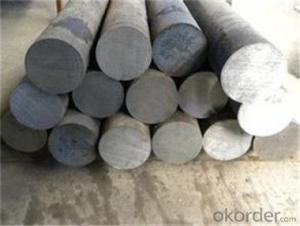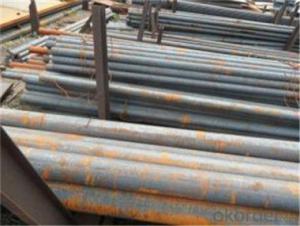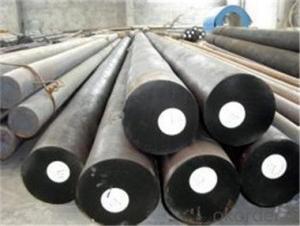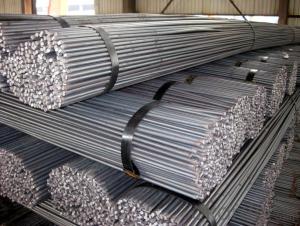Hot Rolled 12mm Steel Rod Price Steel Round Bars
- Loading Port:
- Tianjin
- Payment Terms:
- TT OR LC
- Min Order Qty:
- 33 m.t.
- Supply Capability:
- 2000000 m.t./month
OKorder Service Pledge
OKorder Financial Service
You Might Also Like
Description of steel round bar:
(1) Thickness of not more than 2MM sheet, efficient blanking die, punch die and pressure die etc.
(2) All kinds of scissors, inserts, woodworking blade.
(3) Thread rolling die and wear-resistant slider.
(4) Cold Heading Die, thermosetting resin molding.
(5) Molding in deep drawing cold extrusion dies. it has good strength and good comprehensive mechanical properties.The process is good.
Festures of steel round bar:
4340 Forged Round Steel Bar
1.Dia 80-800mm Length:2000-13000mm or as required
2.Technique:Forged
3.Delivery Time:45 days
Specifications of steel round bar:
Round bar | Diameter(mm) | Length (mm) | |
10~800 | 2000~5800 | ||
plate/sheet | Thickness(mm) | Width (mm) | Length (mm) |
10~800 | 80~2300 | 2000~5800
|
Images of steel round bar:
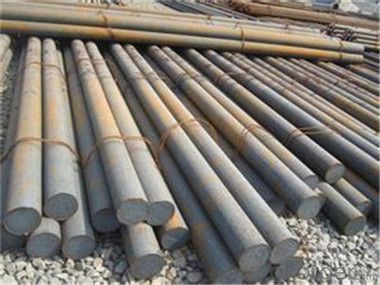
FAQ:
1. What is your package?
Packing situation: standard seaworthy packing or as customer required.
2. How long is the lead time?
Delivery time: 45 days after order confirmed.
3. What payment term do you accept?
Payment: T/T or L/C at sight.
- Q:What is the difference between a solid and a hollow steel round bar?
- A solid steel round bar is a cylindrical bar made entirely of solid steel material, meaning it is filled and does not have any hollow spaces inside. On the other hand, a hollow steel round bar is also cylindrical in shape but has a hollow center, meaning it has empty space or a void inside the bar. The main difference between a solid and a hollow steel round bar lies in their structural composition and the purposes they serve. A solid steel round bar is typically used in applications where strength and durability are of utmost importance. It is commonly used in construction, manufacturing, and engineering projects where load-bearing capacity is required. On the other hand, a hollow steel round bar is designed to be lighter in weight while still maintaining structural integrity. The hollow center allows for weight reduction while still providing sufficient strength for various applications. Hollow steel round bars are often used in industries such as aerospace, automotive, and marine, where weight reduction is critical for improved fuel efficiency and overall performance. Additionally, the hollow space inside a hollow steel round bar also provides an opportunity for customization. It can be used to house other components, such as wires or piping, allowing for a more streamlined and efficient design. This makes hollow steel round bars versatile and suitable for various applications that require both strength and weight reduction. In summary, the main difference between a solid and a hollow steel round bar lies in their structural composition and the purposes they serve. Solid steel round bars are used for applications that require maximum strength and durability, while hollow steel round bars offer weight reduction and customization options, making them suitable for applications that prioritize lightweight design without compromising structural integrity.
- Q:Are steel round bars suitable for food processing applications?
- No, steel round bars are not suitable for food processing applications.
- Q:What are the different surface roughness options for steel round bars?
- There are several different surface roughness options available for steel round bars. These options are typically determined by the manufacturing process and the desired end-use of the steel bars. 1. Hot Rolled: Hot rolled steel round bars have a rough and scaled surface finish. This is due to the high temperature at which the bars are formed, which causes the surface to oxidize and form a layer of scale. This roughness can vary depending on the specific manufacturing process. 2. Cold Drawn: Cold drawn steel round bars are processed at room temperature, resulting in a smoother surface finish compared to hot rolled bars. The cold drawing process involves pulling the steel bars through a die to reduce their diameter, resulting in a more uniform and consistent surface roughness. 3. Peeled and Polished: Peeled and polished steel round bars undergo a secondary process to remove the outer layer of scale or surface defects. This process typically involves peeling the outer layer and then polishing the surface to achieve a smoother and more refined finish. This option provides a high-quality surface with minimal imperfections. 4. Ground: Ground steel round bars are processed through a grinding machine to achieve a precise and smooth surface finish. This process removes any surface defects and irregularities, resulting in a consistent and uniform surface roughness. Ground bars are often used in applications where dimensional accuracy and a smooth surface are required. 5. Turned and Polished: Turned and polished steel round bars are processed on a lathe machine, where the outer layer is removed by turning the bars against a cutting tool. This process results in a smooth and polished surface finish. Turned and polished bars are commonly used in applications where aesthetics and a high-quality surface finish are important. Overall, the choice of surface roughness option for steel round bars depends on the specific requirements of the application. Factors such as dimensional accuracy, surface finish, and aesthetics play a role in determining the most suitable option for a given use case.
- Q:How do steel round bars compare to stainless steel round bars?
- Steel round bars and stainless steel round bars differ in their composition, making them suitable for various applications. The composition of steel mainly consists of iron with small amounts of carbon and other elements, whereas stainless steel is an alloy composed of iron, chromium, and often other elements like nickel or molybdenum. This unique composition gives stainless steel its distinctive properties, such as corrosion resistance. Both steel and stainless steel round bars can be manufactured to have high tensile strength. However, stainless steel generally has higher tensile strength compared to regular steel, making it more suitable for applications requiring additional strength and durability. Another significant difference lies in their resistance to corrosion. Stainless steel round bars have excellent corrosion resistance due to the presence of chromium in their composition, making them ideal for applications exposed to moisture, chemicals, or other corrosive environments. On the other hand, steel round bars are more prone to rust and corrosion and may need additional protective coatings in such environments. In terms of cost, steel round bars are generally more affordable compared to stainless steel round bars. The higher cost of stainless steel is attributed to its unique properties and the additional alloying elements required in its production. Both steel and stainless steel round bars have advantages and specific applications. Steel round bars are commonly used in construction, manufacturing, and general-purpose applications where corrosion resistance is not a primary concern. In contrast, stainless steel round bars find extensive use in industries such as food processing, chemical processing, medical equipment, and marine applications where corrosion resistance is crucial. In conclusion, the choice between steel round bars and stainless steel round bars depends on the specific requirements of the application. Steel round bars are more cost-effective but may require additional corrosion protection, while stainless steel round bars offer superior corrosion resistance and strength.
- Q:What is the difference between a bright and a rough turned steel round bar?
- The primary differences between a bright turned steel round bar and a rough turned steel round bar lie in their surface finishes and the precision involved in their manufacturing processes. A bright turned steel round bar boasts a sleek and shiny surface finish. This is achieved by subjecting the bar to supplementary processes such as polishing or grinding after the initial turning operation. The bright surface finish not only enhances the bar's aesthetic appeal but also provides improved resistance against corrosion. Conversely, a rough turned steel round bar exhibits a more textured surface finish. It is typically obtained directly from the turning operation without any additional refining processes. The rough surface finish may display visible tool marks and a slightly uneven texture. Regarding manufacturing precision, a bright turned steel round bar tends to be more accurate and precise in terms of its dimensions and tolerances. The additional processes involved in attaining a bright surface finish also enable tighter control over the bar's specifications. As a result, bright turned bars are suitable for applications where precise dimensions and tolerances are crucial. In contrast, a rough turned steel round bar may have slightly looser tolerances due to the nature of the turning process and the absence of further refining operations. Nevertheless, rough turned bars can still meet the requirements of many applications that do not necessitate high precision. Ultimately, the choice between a bright turned steel round bar and a rough turned steel round bar hinges on the specific application and the desired surface finish and precision.
- Q:What are the advantages of using nickel-chromium-aluminum alloy steel round bars?
- There are several advantages of using nickel-chromium-aluminum alloy steel round bars. Firstly, this alloy steel offers excellent corrosion resistance, making it ideal for applications in harsh environments or industries where corrosion is a concern. This resistance to corrosion helps extend the lifespan of the round bars, reducing maintenance and replacement costs. Secondly, nickel-chromium-aluminum alloy steel round bars have high strength and durability. This makes them suitable for applications that require heavy loads or need to withstand high temperatures. Their strength also allows for increased structural stability, making them a reliable choice for various construction projects or industrial applications. Additionally, this alloy steel has excellent thermal stability, meaning it can maintain its shape and mechanical properties even at elevated temperatures. This makes it particularly useful in industries such as aerospace, automotive, and power generation, where high temperatures are common. Moreover, nickel-chromium-aluminum alloy steel round bars exhibit good formability and machinability, allowing for easy fabrication and customization. This makes them versatile and adaptable for various manufacturing processes, enabling the production of complex shapes and designs. Lastly, this alloy steel is known for its resistance to oxidation and scaling at high temperatures. This characteristic makes it suitable for applications that involve exposure to extreme heat or rapid temperature changes, such as in furnaces or heat exchangers. In summary, the advantages of using nickel-chromium-aluminum alloy steel round bars include excellent corrosion resistance, high strength and durability, thermal stability, formability, and resistance to oxidation. These qualities make it a preferred choice for a wide range of industries, ensuring reliable performance and longevity in various applications.
- Q:Can steel round bars be coated or plated?
- Yes, steel round bars can be coated or plated. Coating or plating is a common process used to enhance the performance and aesthetics of steel products. There are various coating and plating options available, such as zinc plating, chrome plating, nickel plating, and powder coating. These processes can provide additional protection against corrosion, improve wear resistance, and give the steel a desired appearance. The choice of coating or plating method depends on the specific application and requirements of the steel round bars.
- Q:What are the advantages of using magnesium-alloy steel round bars?
- There are several advantages of using magnesium-alloy steel round bars: 1. Lightweight: Magnesium is one of the lightest structural materials available, making magnesium-alloy steel round bars significantly lighter than traditional steel bars. This makes them ideal for applications where weight reduction is crucial, such as aerospace and automotive industries. 2. High strength-to-weight ratio: Despite being lightweight, magnesium-alloy steel round bars have a high strength-to-weight ratio. This means they can withstand high loads and provide excellent structural integrity while still maintaining a low weight. 3. Corrosion resistance: Magnesium-alloy steel round bars have excellent corrosion resistance properties, making them suitable for outdoor and marine applications. They can withstand exposure to saltwater, humidity, and other corrosive environments without significant degradation. 4. High machinability: Magnesium-alloy steel round bars are known for their superior machinability, allowing for easy shaping, cutting, and drilling. This makes them desirable in industries that require precise and complex component manufacturing. 5. Good heat dissipation: Magnesium has excellent thermal conductivity, which means that magnesium-alloy steel round bars can effectively dissipate heat. This makes them suitable for applications where heat management is critical, such as in heat sinks for electronic devices or engine components. 6. Eco-friendly: Magnesium is a highly recyclable material, and using magnesium-alloy steel round bars can contribute to a more sustainable and environmentally friendly manufacturing process. The ability to recycle and reuse magnesium alloys minimizes waste and reduces the overall environmental impact. 7. Cost-effective: While magnesium alloys may have a higher initial cost compared to traditional steel, their lightweight nature can lead to significant cost savings in transportation and installation. Additionally, their corrosion resistance and durability reduce the need for frequent maintenance and replacement, further lowering long-term costs. In conclusion, the advantages of using magnesium-alloy steel round bars include their lightweight nature, high strength-to-weight ratio, corrosion resistance, high machinability, good heat dissipation, eco-friendliness, and cost-effectiveness. These properties make them a desirable choice for various industries, particularly those that prioritize weight reduction, performance, and durability.
- Q:Can steel round bars be used in the fabrication of machinery?
- Yes, steel round bars can be used in the fabrication of machinery. Steel round bars are often chosen for their high strength and durability, making them suitable for various applications in machinery fabrication. Additionally, their uniform shape and ease of machining make them versatile for use in different components and structures of machinery.
- Q:What are the different types of steel round bar alloys for improved machinability and strength?
- Some of the different types of steel round bar alloys for improved machinability and strength include free-cutting steel, alloy steel, and tool steel. Free-cutting steel is specifically designed to be easily machinable, allowing for faster and more efficient machining processes. Alloy steel contains various additional elements such as chromium, nickel, or molybdenum, which enhance its strength and wear resistance. Tool steel is a high-performance alloy that is often used in the production of cutting tools and machinery components, offering exceptional hardness and durability.
1. Manufacturer Overview |
|
|---|---|
| Location | |
| Year Established | |
| Annual Output Value | |
| Main Markets | |
| Company Certifications | |
2. Manufacturer Certificates |
|
|---|---|
| a) Certification Name | |
| Range | |
| Reference | |
| Validity Period | |
3. Manufacturer Capability |
|
|---|---|
| a)Trade Capacity | |
| Nearest Port | |
| Export Percentage | |
| No.of Employees in Trade Department | |
| Language Spoken: | |
| b)Factory Information | |
| Factory Size: | |
| No. of Production Lines | |
| Contract Manufacturing | |
| Product Price Range | |
Send your message to us
Hot Rolled 12mm Steel Rod Price Steel Round Bars
- Loading Port:
- Tianjin
- Payment Terms:
- TT OR LC
- Min Order Qty:
- 33 m.t.
- Supply Capability:
- 2000000 m.t./month
OKorder Service Pledge
OKorder Financial Service
Similar products
New products
Hot products
Hot Searches
Related keywords
